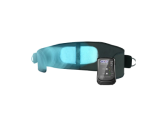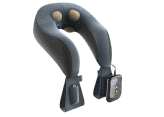Pain in the lower limbs can be intrusive, inconvenient and restricting. More specifically, joint pain including hip, knee and ankle pain can make it difficult to move, work, run errands or do the activities you enjoy.
And while more chronic forms of pain can be difficult to treat effectively, committing to pain relief and management can help pain sufferers improve their quality of life. Understanding that this process is about more than just relying on medication is an important first step.
So, where do you start? Recognizing and identifying your symptoms is a solid first step towards finding what method of pain management and joint relief suits your needs. Healthcare providers assess a person's symptoms to guide diagnosis, often looking for pain and swelling, swollen joints, and the specific painful area involved. Joint pain can also be a symptom of other health conditions and related disorders, affecting multiple joints or specific areas, and may be caused by joint inflammation. Common features include pain and swelling, swollen joints, and discomfort in the painful area. There are many common forms of arthritis, such as rheumatoid arthritis, psoriatic arthritis, lupus, gout, ankylosing spondylitis, and reactive arthritis. Rheumatoid arthritis and other rheumatic diseases are autoimmune diseases affecting multiple joints and can present with a variety of symptoms. Keep reading to learn more about the causes of joint pain in the lower limbs and to discover methods for joint pain management.

Introduction to Joint Pain
Joint pain is a widespread health condition that can affect people of all ages, often making everyday activities challenging and uncomfortable. Whether it’s a dull ache or severe pain, joint discomfort can limit your mobility and impact your overall quality of life. Joint pain can be short-term, following an injury, or it can become a chronic issue that persists for months or even years.
There are many causes of joint pain, and understanding them is key to finding the right joint pain treatment. Some of the most common causes include injuries, infections, and chronic diseases. Osteoarthritis is the most common cause of joint pain, especially as we age, due to the gradual wearing down of cartilage in the affected joint. Inflammatory conditions, such as rheumatoid arthritis, psoriatic arthritis, and systemic lupus erythematosus, are autoimmune diseases where the immune system mistakenly attacks healthy joint tissue, leading to joint swelling, pain, and stiffness.
Joint pain can affect any joint in the body, but it most often targets weight-bearing joints like the hips, knees, and spine. Small joints, such as those in the fingers, toes, and even the big toe, can also be affected. Symptoms can vary from mild discomfort to severe pain, and may include joint stiffness, swelling, morning stiffness, and even sleep disturbances. Sometimes, joint pain is accompanied by other symptoms like fatigue or fever, which can signal an underlying health condition.
Managing joint pain often starts with simple steps like rest, applying ice, and using over-the-counter pain relievers. Physical therapy, including low impact aerobic exercise and stretching exercises, can help relieve pain and improve joint function. For more persistent or severe pain, your healthcare provider may recommend anti-inflammatory medicines or, in some cases, joint replacement surgery.
If you experience joint pain that is severe, persistent, or comes with other symptoms such as redness, swelling, or fever, it’s important to seek medical attention. A healthcare professional will review your medical history, perform a physical exam, and may order blood tests or imaging tests to determine the underlying causes of joint pain. Early diagnosis and treatment are essential to ease joint pain, prevent further joint damage, and help you maintain an active, healthy lifestyle.

Hip Joint Pain
The hip joint plays a major role in one’s mobility and at the same time, it withstands a large amount of the body’s weight; this makes the hip joint very susceptible to wear and tear, injury and degeneration. Degeneration of the hip joint can involve damage to the bones and worn cartilage, both of which contribute to pain and reduced mobility. Some of the most common causes of pain in the hip joint are:
-
Arthritis; the most common cause of hip pain. Age is a risk factor for developing arthritis.
-
Acute injuries, fractures, tears and dislocation.
-
Conditions including bursitis and tendinitis that wear down tissues surrounding the joint.
Tips to Relieve Pain for Hip Joint Relief: Strengthen and Exercise Safely
When you’re dealing with hip pain that can already make movement painful, stretching or exercising is probably the last thing you want to do. However, refraining from movement may actually be making your pain worse by encouraging stiffness and preventing blood circulation. Proper circulation is thought to help your bloodstream deliver oxygen and nutrients to damaged tissues, encouraging healing.
Staying mobile despite your pain can help you improve your flexibility and range of motion, and strengthening the surrounding muscles through exercise can reduce the stress on your hip joint over time. Weak muscles can lead to more stress on the hip joint, which may contribute to muscle loss if not addressed. A crucial part of this is ensuring that you’re moving safely so as to not worsen your pain or cause a flare-up. Follow these tips to stretch and exercise with caution:
-
Start with light, gentle movement: Ease yourself into exercise with a warm-up, every time. We recommend starting with a full-body stretch that helps you loosen up before going into strengthening or aerobic exercises.
-
Keep the impact low: Try low-impact exercises with the help of stationary equipment such as an elliptical or recumbent bicycle. Water aerobics can also help lessen physical stress on joints while you exercise.
-
Use ice post-workout: Apply ice to the hip joint after exercise to prevent swelling and discomfort.

Knee and Ankle Joint Pain
Pain in the leg joints including the knees and ankles often starts from repeated motions or acute injuries, especially if you work or enjoy hobbies that require lots of time on your feet, or if you are particularly physically active. Other conditions can also cause pain in these areas; continue reading to learn more.
Knee Joint Pain
-
Arthritis: A common cause of joint pain including the knee joint.
-
Bursitis: Also known as “preacher’s knee”.
-
Tendinitis and the degeneration of other tissues surrounding the joint.
-
Acute injuries, fractures, tears and dislocation.
Bone spurs and worn cartilage are common findings in osteoarthritis of the knee and can contribute to pain and joint dysfunction.
Ankle Joint Pain
-
Sprains or “rolling” the ankle, causing damage to surrounding cartilage and tendons.
-
Gout: A condition that can cause joint swelling.
-
Arthritis.
Try these tips when looking to get active while dealing with knee and ankle joint pain, too. Check out our video featuring exercise moves for those dealing with pain in the knee joint:
Tips for Knee and Ankle Pain Joint Relief: The P.R.I.C.E Method
Both knee and ankle pain can benefit from the P.R.I.C.E method of pain management. Let’s dive into what each letter stands for in this acronym.
P: Protection
When pain strikes, immobilize the area with a device such as a wrap, brace or splint so as to prevent further pain and discomfort.
R: Rest
Not only is high-quality sleep important to recovery from pain but taking a break from activities and movements that trigger pain can help as well. This often means staying off your feet, avoiding any bending motions and avoiding the flexion of the knee or ankle.
I: Ice
Apply ice to the pain-affected area for 10-15 minutes at a time to reduce swelling and inflammation.
C: Compression
Use a wrap as a compression device to find support and to minimize swelling.
E: Elevation
Elevate the leg higher than the heart to keep fluid from building up in the painful joint and to find relief from inflammation.
It's clear that joint pain in the lower limbs can derive from many different sources. The cause of your joint pain may even be entirely unknown; the bottom line is, it doesn't have to control your quality of life. Hip, knee and ankle joint pain can be successfully managed from home.

TENS Therapy for Joint Pain Relief
Regardless of what kind of lower limb joint pain you’re experiencing, TENS Therapy (Transcutaneous Electrical Nerve Stimulation) can be beneficial and meaningful in your pain management routine. TENS therapy is specifically designed to help those who feel pain from joint conditions by providing targeted relief.
TENS Therapy is a versatile pain therapy that is found in DR-HO’S devices including the Pain Therapy System 4-Pad. It works to deliver gentle electric currents through the nervous system to “prevent” pain signals from reaching the brain, thus helping joint pain sufferers find temporary pain relief when they need it the most.
Learn more about TENS here:
-
Discover the Pain Therapy System 4-Pad for TENS therapy that can be used anywhere on the body.
-
Find out how to place your body pads to target different kinds of joint pain.
-
Learn more about how a TENS machine works behind-the-scenes to temporarily relieve pain.

Take action now to start feeling better, sooner.
We hope that this information helps empower you with knowledge to take meaningful steps towards alleviating your joint pain. Upgrade your pain management routine to keep pain at bay and to get back to the things you love.
Disclaimer: This content is for informational purposes, and should not be treated as medical advice. While our advanced TENS machine can benefit various pain conditions through its sophisticated combination of TENS, EMS, and NMES guided by our proprietary AMP Technology, proper diagnosis ensures optimal pad placement and treatment protocols. Always consult a healthcare professional for an accurate diagnosis before beginning any treatment program.







